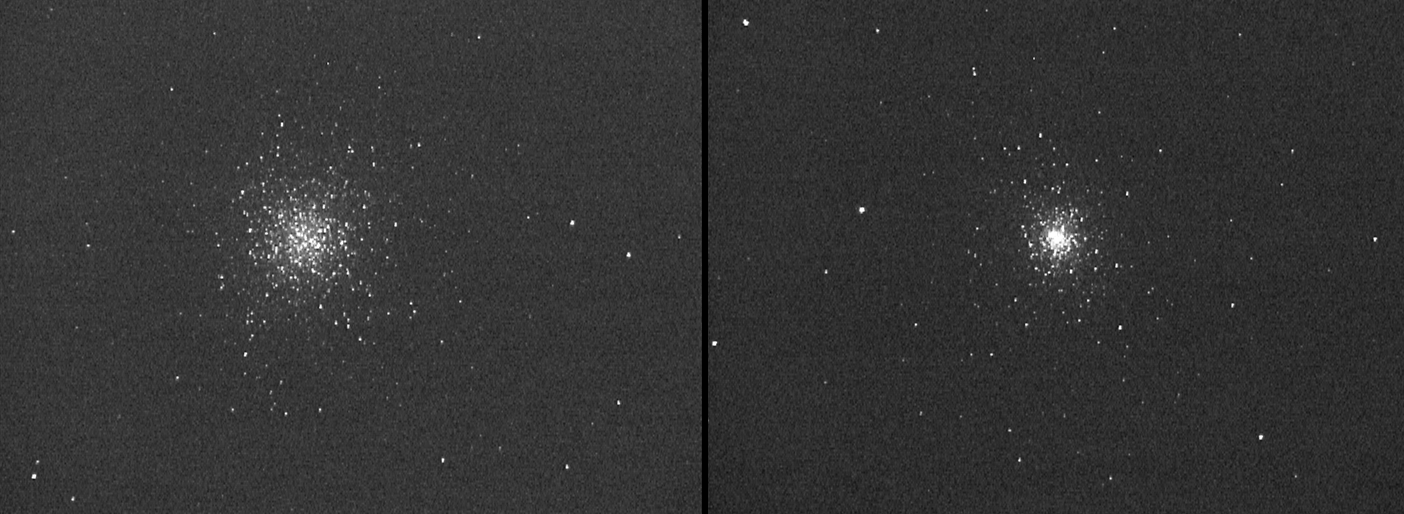Observation by Alex Pratt: Globular clusters Messier 13 and 92 in H...
Uploaded by
Alex Pratt
Observer
Alex Pratt
Observed
2019 Aug 11 - 20:22
Uploaded
2019 Aug 16 - 11:35
Objects
M92
The Great Globular Cluster in Hercules (M13)
Equipment
- C11 f/10 @ f/3.3
- Watec 910HX video camera
- OccuRec (recording)
- Tangra (playback)
Exposure
0.32s
Location
Leeds, West Yorkshire
Target name
Messier 13 and Messier 92
Title
Globular clusters Messier 13 and 92 in Her
About this image
Video is a medium ideally suited for recording transitory events such as meteors, occultations and astrometry of fast-moving NEOs, but I also like to use it to observe favourites in the Messier and Caldwell catalogues.
Having just monitored an asteroidal occultation I redirected my C11 onto Her, where the globular clusters M13 and M92 were riding high. Using an integration setting of x16 (0.32s) it was great to view these well-known objects in almost real-time to mag 15. The attached images are examples of individual video frames.
Files associated with this observation
Like this image
Jeremy Shears,
David Swan,
Andy Wilson,
Mr Leonard Entwisle,
Ray Emery,
Dawson,
Chris Dole,
Graham Winstanley,
Andrew Dumbleton,
Peter Carson,
Tom Moran,
Dr Paul Leyland,
Alan P Buckman
Comments
That's a really interesting method, Alex. So, do I understand correctly that each image was a 0.32 sec exposure? Remarkable.
A short exposure does mean that you get good resolution even at the centre of the cluster.
Is there the possibility to integrate for longer? And can the image be processed to remove dark pixel or hot pixels should there be any?

Thanks Jeremy.
Analogue video cameras pump out frames at a constant rate of 25/sec (PAL standard, 50 interleaved fields/sec). Models like the Watec 910 can integrate, so they can be set to internally stack 2, 4, 8, 16 or more frames, then output a steady stream of these integrated frames. OccuRec can read this stream and individual frames from its resultant file can be saved as BMP, FITS.
In this example I used an integration setting of x16 (16 video fields = 16 x 0.02s exposures = 0.32s) and adjusted the AGC (gain control) to optimise the view, balanced between reaching a good lim. mag. and avoiding overexposure from local light pollution. The video integration and gain can be adjusted to bring out different features. This stacking from 8-bit video cameras doesn't match the well depth achieved by 16-bit CCDs, although expensive 12-bit video cameras are available.
Just like with standard CCD images, you can also take video darks, video flats, video bias recordings of a few seconds' duration. Tangra can process these and create dark and flat BMPs and apply them to the video. This is useful when recording an important event such as the Triton occultation, where Paris Observatory requested that darks and flats be included in our data submissions.
much appreciated. Hopefully you will share some more images taken this way in the future.
Copyright of all images and other observations submitted to the BAA remains with the owner of the work.
Reproduction of work by third parties is expressly forbidden without the consent of the copyright
holder. By submitting images to this online gallery, you grant the BAA permission to reproduce them in
any
of our publications.


